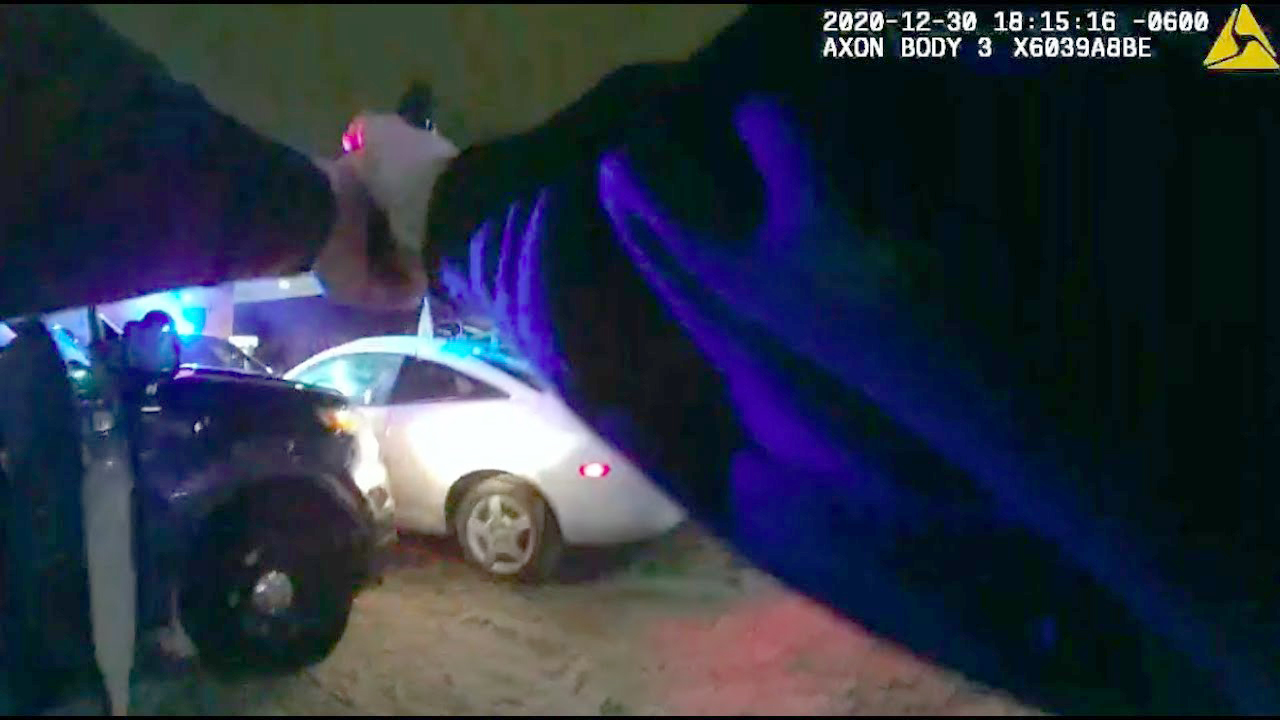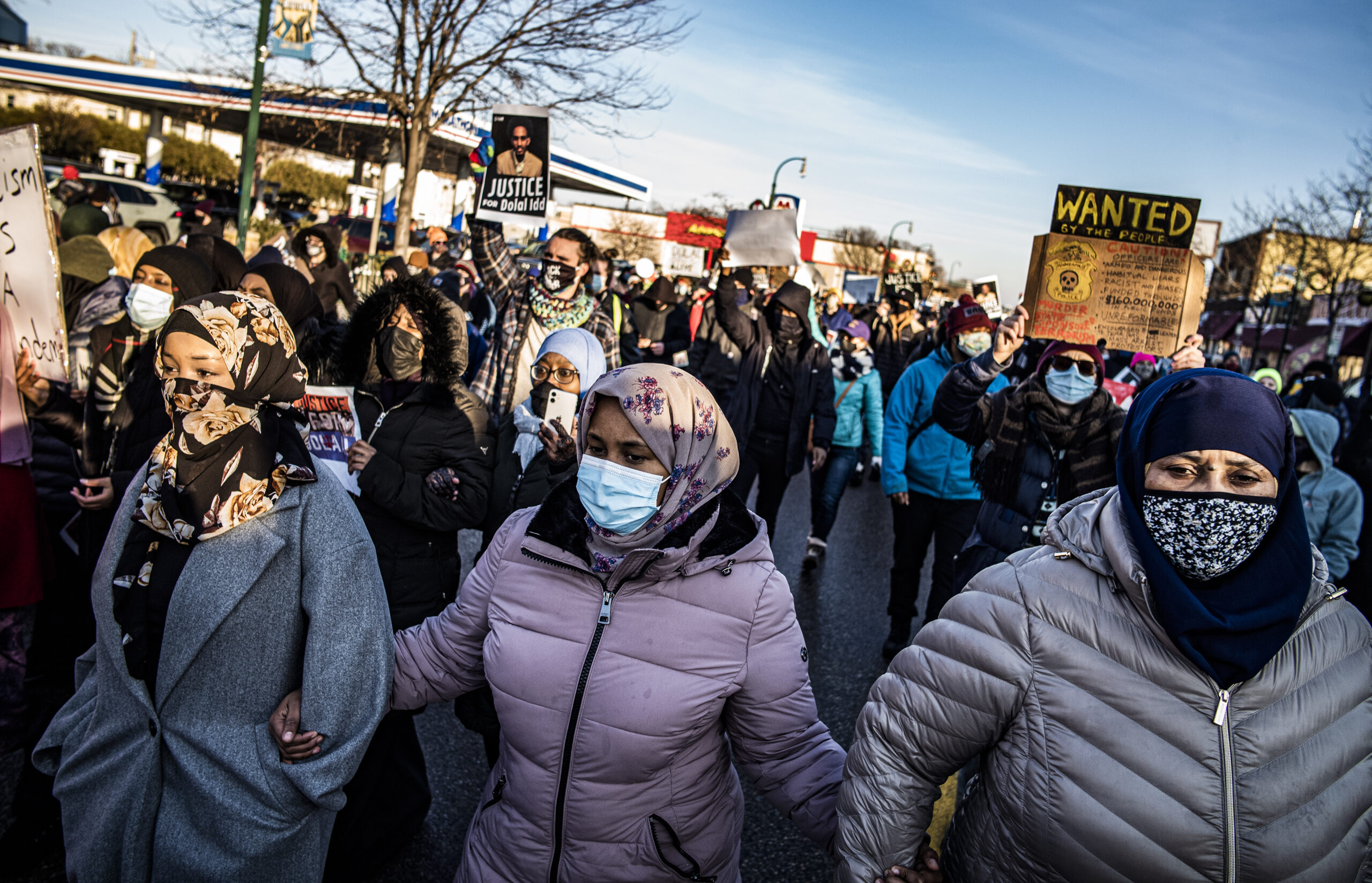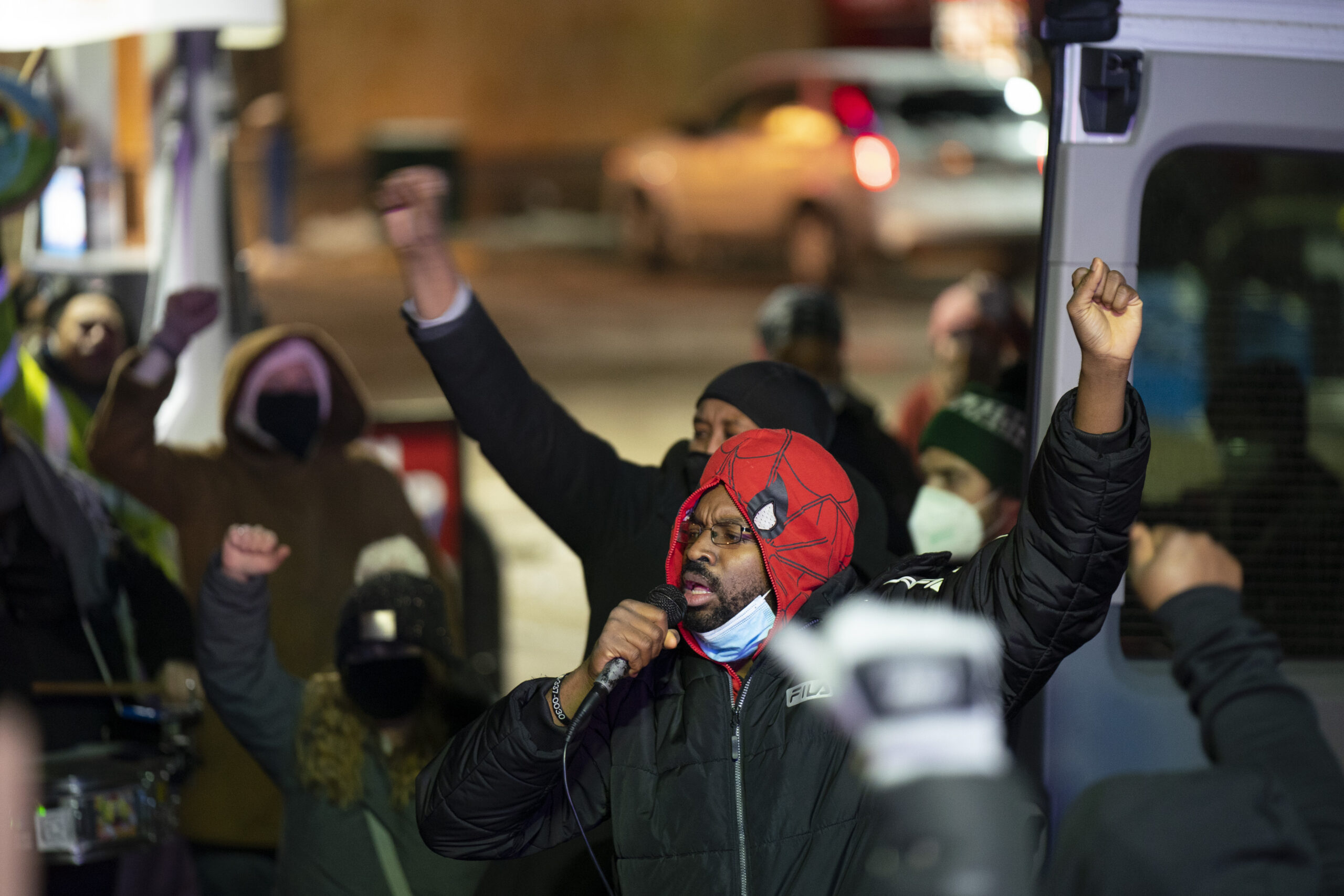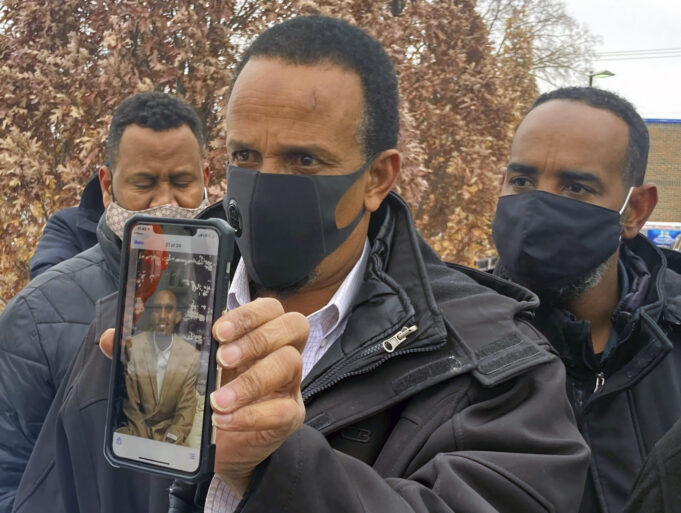Family, activists, and support organizations in the Somali-American community are pressing for answers about the police killing of Dolal Idd, 23, a young Somali-American in Minneapolis, Minn.
The fatal encounter begins with an informant, according to police, and trying to catch Mr. Idd in an illegal gun purchase. At presstime, The Final Call was unable to get clear answers from police about whether cars that surrounded Mr. Idd in a gas station were marked, unmarked or a combination of police vehicles.
There were deep concerns about an alleged police sting taking place in a very public place, possibly putting others at risk, and whether there was overkill when officers fired their weapons.
Minneapolis police said the encounter turned deadly when Mr. Idd fired a gun at officers. His family and community advocates don’t believe the police claims.
“The MPD was conducting a traffic stop involving a felony suspect,” said Police Chief Medaria Arradondo, hours after the shooting.

The police chief told the press eyewitnesses said a shot was fired from the car first, then cops returned fire killing Mr. Idd on Dec. 30. Police released bodycam footage the following day. The 27-second clip showed a white sedan pinned between police vehicles in the parking lot of the Holiday gas station in South Minneapolis with a barrage of gunfire from three officers hitting the driver’s side of the car. While there were no injuries to the police, Mr. Idd was pronounced dead on the scene and a young woman in the passenger seat was unharmed. A press release from the Hennepin County Medical Examiner said the “manner of death is homicide” from multiple gunshot wounds.
There are questions about whether officers exhausted all reasonable alternatives before using deadly force.
“The video released today is inconclusive and warrants an independent and transparent investigation. We must see all the videos and we demand justice for Dolal Idd,” said Jaylani Hussein, executive director of the Minnesota branch of CAIR (Council on American–Islamic Relations), a Muslim civil rights and advocacy group. Mr. Hussein added, “We also are outraged after learning (about) the terrifying home raid that could have resulted in tragedy.”
Longtime Minneapolis-based activist Spike Moss told The Final Call that what has people upset is cops had him surrounded. It could have been handled differently, he said.
“It was like overkill … three officers shooting at the same time without no regard to the innocent person sitting in the car with him,” said Mr. Moss.
He doubts Minneapolis police will address the overkill question. The department’s history, which includes officers involved in the videotaped death of George Floyd and a White cop kneeling on his neck, includes rare instances where cops are disciplined, fired, charged or go to court. Mr. Floyd’s death last year was one of those rare cases.
“There’s far too many White males with charges against them … violations against citizens,” Mr. Moss argued, pointing out reports that one of the officers named in Mr. Idd’s shooting has 27 infractions on his record.
Nationwide police officers are hardly charged in on-duty shootings, much less convicted. Data shows that since 2015, U.S. police officers have shot and killed between 900 to 1,000 people each year. During a Jan. 12 press conference, Lee Hutton III, the attorney representing Mr. Idd’s family, called for the release of all video footage.
“This is not only the responsibility of society, this is not only the responsibility for the family to (have an) answer, this is the responsibility of everyone,” said Atty. Hutton.
He called on Minneapolis Mayor Jacob Frey, Hennepin County Sheriff David Hutchinson and police Chief Arradondo to meet about the transparency of the investigation.

Atty. Hutton declined to talk about a possible civil lawsuit by the family.
Despite a swift release of a video, others agree the footage is “indecipherable” and questions remain around what led to the fatal shooting. Some argued being under suspicion of a crime should not end in murder.
In a statement Dec. 30, Mayor Frey spoke about the racial tumult in the city and tattered relationship between cops and communities of color. “Events of this past year have marked some of the darkest days in our city,” said Mayor Frey. “We know a life has been cut short and that trust between communities of color and law enforcement is fragile. Rebuilding that trust will depend on complete transparency,” he added.
However, there are questions on how the police handled both the stop and the Idd family in its aftermath. Activists say the ordeal is indicative of how “Black, Indigenous, and People of Color (BIPOC)” are treated in the U.S.
“The police have lost the public trust, especially within BIPOC communities,” said Omar Fatah, a Somali-American state senator-elect. “My heart aches for the family,” he said in a joint statement with the Minnesota chapter of CAIR. State Senator Fatah said it is “deeply disturbing” when a community member is killed by the police.
Minneapolis police said its Community Response Team was using an informant to buy a “Mac-10 high-capacity pistol” from Mr. Idd and claimed he had more guns at his parents’ home in the Eden Prairie suburb.
Police state they recovered two guns at the scene of the fatal encounter, one they say Mr. Idd fired at them and another they say he was selling to the informant.
A partial 28-minute bodycam video released by the Hennepin Sheriff’s Department showed cops arrayed in combat military gear, and weapons drawn entering Mr. Idd’s family home in a 2:20 a.m. raid the early morning after the killing.
Throughout the ordeal the Muslim family can be heard as they sat in horror at gunpoint around the living room floor saying “Allah-U-Akbar” (God is the Greatest) seeking refuge in God as they waited for the ordeal to end.
The cops searched the house as the family sat bewildered and scattered in the living room. The video showed adults’ wrists being zipped-tied with plastic handcuffs. An 18-year-old boy was ordered tied from the back. A female is heard requesting the front door, left wide open by the cops, be closed to block off the sub-0 temperatures pouring into the room.
The video redacted the faces and silenced the names of Mr. Idd’s family members as a deputy asked each person, including the children, their names. They weren’t informed of their son and brother’s death until after the encounter.
A report released Jan. 3 by the Bureau of Criminal Apprehension said no weapons were found at the home.
The day after the raid Mr. Idd’s father, Bayle Adod Gelle, a Somali immigrant, in his 60s, told the Sahan Journal, sheriff deputies pointed guns at him, his wife, Nima Ade, and three of their young children. The family doesn’t believe the police story that Mr. Idd fired a weapon first and charged officers with police brutality.
According to a search warrant, police wanted to search the home before the family was told about Mr. Idd’s death, claiming concerns about potential evidence tampering, which activists and relatives rejected.

“As far as the video there was a lack of training in instances like this,” said Huda Yusuf, a Minneapolis-based community activist. “It’s a question … did you send the right officers into the situation?” she asked, referring to cultural insensitivity during the search of the home.
Advocates for radical change in policing say the fatal shooting of Mr. Idd showed the limited worth of Black life in America. Regardless of background, socioeconomic status, religion, or education, once again “Black” appears to be the determining factor for elimination by police, they said.
Whether its Black Somali immigrants from the Horn of Africa, 8,000 miles away, or Black former slaves persecuted in America for 466 years, they are united by the propensity to lose their lives to police violence, they added.
“I think when it comes down to being a person of color, most of the time the first thing that folks look at, at least in Minnesota … is the color,” said Ms. Yusuf.
“Is he African-American or is he Somali?” she asked.
The activist said White racism is pushing the two communities closer. “They look like each other, but they don’t understand each other’s struggles,” said Ms. Yusuf. But profiling by law enforcement and systemic racism that both communities suffer are shared experiences, and now points of solidarity.
Some say there is a double standard in how police handle Blacks and Whites in volatile situations.
They point to a September 2020 incident involving Ricardo Baldazoof, a Caucasian, who fired multiple gunshots at Burnsville, Minn. police from inside his house and was allowed to surrender alive. Despite being charged with attempted murder of officers, arrested with loaded handguns and an unloaded Glock pistol, he was allowed to bond out of jail on condition to remain law-abiding until his March 2021 court date.
In the midst of freezing temperatures, people gathered at the place of Mr. Idd’s killing. Some took to social media spreading the hashtag #justicefordolal, others held vigils and gatherings demanding fair dealing from a city that months before reeled with protests and clashes over the harrowing death of George Floyd. Some activists renewed calls to abolish the police.
Mr. Idd died a mile from the street where cell phone video captured the White cop fatally kneeling on Mr. Floyd’s neck for nearly nine minutes, as the Black man pleaded “I can’t breathe” before dying. That death sparked days of unrest across America and international protests.

The fatal shooting of Mr. Idd was the first deadly force incident in Minneapolis since Mr. Floyd’s death. It remains a sore spot in a city made up of Whites, Blacks and a mixture of Latino, Asian and East African people.
Minnesota police have had an antagonistic relationship with the Black, Brown, and Red communities. Activists said with past police killings of Jamar Clark, Philando Castile, Isak Aden, and Mr. Floyd, Mr. Idd’s death triggered additional distrust of cops.
The Bureau of Criminal Apprehension said the three officers involved in the shooting were Paul Huynh, a six-year officer; Sgt. Darcy Klund, a 33-year veteran; and Jason Schmitt, a 23-year veteran.
As is standard procedure the officers were placed on paid administrative leave pending investigation by the Minnesota Bureau of Criminal Apprehension, the state’s investigatory agency.
“It is also important that we highlight that Dolal Idd, is Somali, Muslim and a Black immigrant,” said the Black Immigrant Collective in a tweet.
“Around the state, Somalis are hyper surveilled and targeted by local, state and federal agencies. The criminalization of Black Minnesotans looks like Dolal Idd’s interaction w/ MPD,” they said.
Final Call writer Anisah Muhammad contributed to this report.













